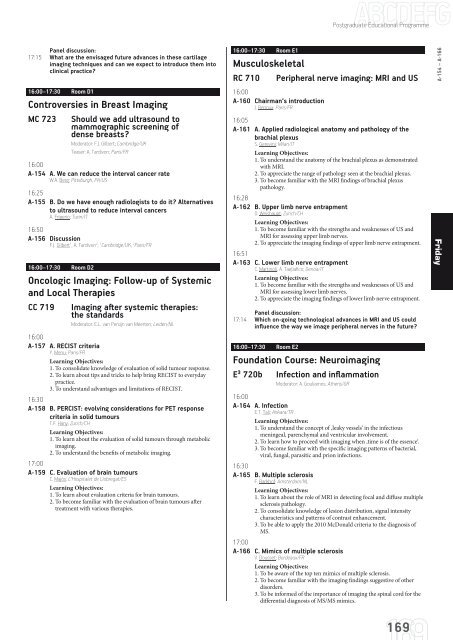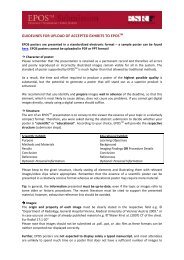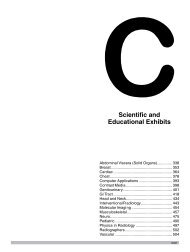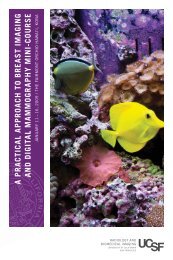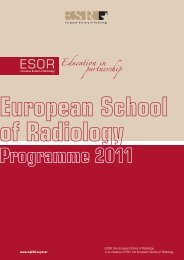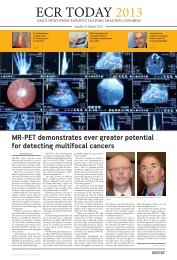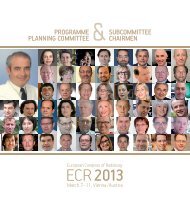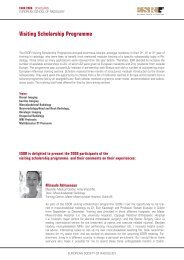ECR 2013 â Final Programme - myESR.org
ECR 2013 â Final Programme - myESR.org
ECR 2013 â Final Programme - myESR.org
- No tags were found...
You also want an ePaper? Increase the reach of your titles
YUMPU automatically turns print PDFs into web optimized ePapers that Google loves.
Postgraduate Educational <strong>Programme</strong>Panel discussion:17:15 What are the envisaged future advances in these cartilageimaging techniques and can we expect to introduce them intoclinical practice?16:00–17:30 Room D1Controversies in Breast ImagingMC 723 Should we add ultrasound tomammographic screening ofdense breasts?Moderator: F.J. Gilbert; Cambridge/UKTeaser: A. Tardivon; Paris/FR16:00A-154 A. We can reduce the interval cancer rateW.A. Berg; Pittsburgh, PA/US16:25A-155 B. Do we have enough radiologists to do it? Alternativesto ultrasound to reduce interval cancersA. Frigerio; Turin/IT16:50A-156 DiscussionF.J. Gilbert 1 , A. Tardivon 2 ; 1 Cambridge/UK, 2 Paris/FR16:00–17:30 Room D2Oncologic Imaging: Follow-up of Systemicand Local TherapiesCC 719 Imaging after systemic therapies:the standardsModerator: E.L. van Persijn van Meerten; Leiden/NL16:00A-157 A. RECIST criteriaY. Menu; Paris/FRLearning Objectives:1. To consolidate knowledge of evaluation of solid tumour response.2. To learn about tips and tricks to help bring RECIST to everydaypractice.3. To understand advantages and limitations of RECIST.16:30A-158 B. PERCIST: evolving considerations for PET responsecriteria in solid tumoursT.F. Hany; Zurich/CHLearning Objectives:1. To learn about the evaluation of solid tumours through metabolicimaging.2. To understand the benefits of metabolic imaging.17:00A-159 C. Evaluation of brain tumoursC. Majós; L‘Hospitalet de Llobregat/ESLearning Objectives:1. To learn about evaluation criteria for brain tumours.2. To become familiar with the evaluation of brain tumours aftertreatment with various therapies.16:00–17:30 Room E1MusculoskeletalRC 710 Peripheral nerve imaging: MRI and US16:00A-160 Chairman‘s introductionJ. Renoux; Paris/FR16:05A-161 A. Applied radiological anatomy and pathology of thebrachial plexusS. Gerevini; Milan/ITLearning Objectives:1. To understand the anatomy of the brachial plexus as demonstratedwith MRI.2. To appreciate the range of pathology seen at the brachial plexus.3. To become familiar with the MRI findings of brachial plexuspathology.16:28A-162 B. Upper limb nerve entrapmentD. Weishaupt; Zurich/CHLearning Objectives:1. To become familiar with the strengths and weaknesses of US andMRI for assessing upper limb nerves.2. To appreciate the imaging findings of upper limb nerve entrapment.16:51A-163 C. Lower limb nerve entrapmentC. Martinoli, A. Tagliafico; Genoa/ITLearning Objectives:1. To become familiar with the strengths and weaknesses of US andMRI for assessing lower limb nerves.2. To appreciate the imaging findings of lower limb nerve entrapment.Panel discussion:17:14 Which on-going technological advances in MRI and US couldinfluence the way we image peripheral nerves in the future?16:00–17:30 Room E2Foundation Course: NeuroimagingE³ 720b Infection and inflammationModerator: A. Gouliamos; Athens/GR16:00A-164 A. InfectionE.T. Tali; Ankara/TRLearning Objectives:1. To understand the concept of ‚leaky vessels‘ in the infectiousmeningeal, parenchymal and ventricular involvement.2. To learn how to proceed with imaging when ‚time is of the essence‘.3. To become familiar with the specific imaging patterns of bacterial,viral, fungal, parasitic and prion infections.16:30A-165 B. Multiple sclerosisF. Barkhof; Amsterdam/NLLearning Objectives:1. To learn about the role of MRI in detecting focal and diffuse multiplesclerosis pathology.2. To consolidate knowledge of lesion distribution, signal intensitycharacteristics and patterns of contrast enhancement.3. To be able to apply the 2010 McDonald criteria to the diagnosis ofMS.17:00A-166 C. Mimics of multiple sclerosisV. Dousset; Bordeaux/FRLearning Objectives:1. To be aware of the top ten mimics of multiple sclerosis.2. To become familiar with the imaging findings suggestive of otherdisorders.3. To be informed of the importance of imaging the spinal cord for thedifferential diagnosis of MS/MS mimics.A-154 – A-166Friday169


